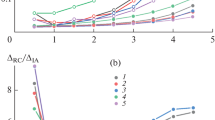Abstract
Observing inclusions on a polished plane, researchers do not see these inclusions directly, but only their cross sections. Meanwhile, the given size of a section can be obtained from the inclusions of different sizes. The true sizes of the inclusions and their quantities are hidden from the researchers. This paper proposes a new method for determining the size distribution of inclusions derived from the size distribution of their sections. The method based on mathematical statistics allows evaluating the true sizes and quantities of inclusions. A notable feature of the method is that it enables a researcher to derive the confidence sets for the distribution functions. A special technique for testing the method has been developed. Numerous tests have shown good adequacy of the method.


Similar content being viewed by others
Notes
If you want to carry out the calculations by this computer program, email me at 'drozinad@gmail.com' and I'll send it to you.
References
T. Lipiński, A. Wach, Size of non-metallic inclusions high-grade medium carbon steel. Arch. Foundry Eng. 14(4), 55–60 (2012)
K. Lambrighs, L. Verpoest, B. Verlinden, M. Wevers, Influence of non-metallic inclusions on the fatigue properties of heavily cold drawn steel wires. Proc. Eng. 2, 173–181 (2010)
D. Zeng, G. Tian, F. Liu, T. Shi, Z. Zhang, H. Junying, W. Liu, Z. Ouyang, Fatigue strength prediction of drilling materials based on the maximum non-metallic inclusion size. JMEP 24(12), 4664–4672 (2015)
D. Janis, A. Karasev, P.G. Jönsson, Evaluation of inclusion characteristics in low-alloyed steels by mainly using PDA/OES method. ISIJ Int. 55(10), 2173–2181 (2015)
D. Janis, R. Inoue, A. Karasev, P.G. Jönsson, Application of different extraction methods for investigation of nonmetallic inclusions and clusters in steels and alloys. Adv. Mater. Sci. Eng. (2014). doi:10.1155/2014/210486
J. Chraponski, J. Cwajna, M. Malinski, Usefulness evaluation of the stereological methods applied for grain size estimation. Acta stereol 18(1), 81–88 (1999)
A. Davtian, U. Hahn, J. Ohser, D. Stoyan, Estimating number density NV—a comparison of an improved Saltykov estimator and the disector method. Image Anal Stereol 19, 209–214 (2000)
R.S. Anderssen, A.J. Jakeman, Computational methods in stereology, in Proceedings of the Fourth International Congress for Stereology, U.S. government printing office, Washington, pp. 13–18 (1976)
A.J. Jakeman, R.S. Anderssen, On optimal forms for stereological data, in Proceedings of the Fourth International Congress for Stereology, U.S. government printing office, Washington, pp. 69–74 (1976)
M.G. Kendall, P.A.P. Moran, Geometric Probability (Charles Griffin, London, 1963)
M. Tanemura, Estimation of linear functionals by maximum likelihood, in Proceedings of the First International Symposium for Science on Form, KTK Scientific Publishers, Tokyo, pp. 157–165 (1986)
W.L. Nicholson, On optimal forms for stereological data, in Proceedings of the Fourth International Congress for Stereology, U.S. government printing office, Washington, pp. 19–24 (1976)
W. Feller, An Introduction To Probability Theory and Its Applications, 1, 3 edn. (John Wiley & Sons Inc, New York, 1968)
P.E. Gill, W. Murray, Numerical Methods for Constrained Optimization (Academic Press, London, 1974)
Author information
Authors and Affiliations
Corresponding author
Appendix
Appendix
The values of the coefficients θ ij for Eq 20 for the next partition of inclusion diameter are as follows.
Rights and permissions
About this article
Cite this article
Drozin, A.D. Calculating of the True Sizes and the Numbers of Spherical Inclusions in Metal. Metallogr. Microstruct. Anal. 6, 240–246 (2017). https://doi.org/10.1007/s13632-017-0354-9
Received:
Revised:
Accepted:
Published:
Issue Date:
DOI: https://doi.org/10.1007/s13632-017-0354-9




